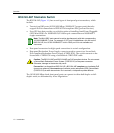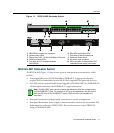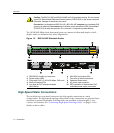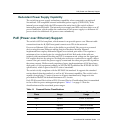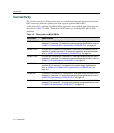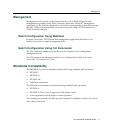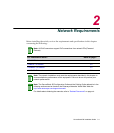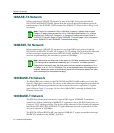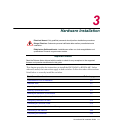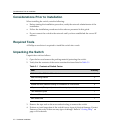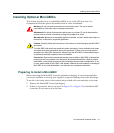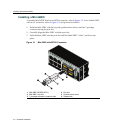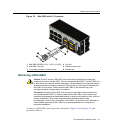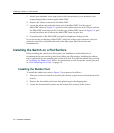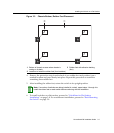
10BASE-TX Network
2-2 Network Requirements
10BASE-TX Network
Whenconnectinga10BASE‐TXsegmenttooneoftheRJ45 fixedportsonboththe
B3G124‐24PandtheB3G124‐48P,ensurethatthe networkmeetstheEthernetnetwork
requirementsoftheIEEE802.3‐2002standardfor10BASE‐TX.RefertotheCablingGuide
fordetails.
100BASE-TX Network
Whenconnectinga100BASE‐TXsegmenttooneoftheRJ45fixedportsonboththe
B3G124‐24PandtheB3G124‐48P,useCategory5UTPcabling.Theswitchattheotherend
ofthetwistedpairsegmentmustmeetIEEE802.3‐2002100BASE‐TXFastEthernet
networkrequirementsforthe
switchestooperateat100 Mbps.
1000BASE-FX Network
TheMini‐GBICportsocketsontheB3G124‐24PandB3G124‐48Penableyoutovarythe
typeof1‐Gbpsportconnection.Thedeviceattheotherendofthesegmentmustmeetthe
sameGigabitEthernetrequirementsfortheconnecteddevicestooperateat1‐Gigabit
speed.Referto
Table 1‐2onpage 1‐6foralistofMini‐GBICscurrentlyavailablefrom
Enterasys Networks.
1000BASE-T Network
TheRJ45fixedfrontpanelconnectorssupportRJ45copper1000BA SE ‐Tcompliant
connections.Whenconnectinga1000BASE‐TsegmenttooneoftheRJ45fixedports,use
Category5UTPcablingorbetter.Thedeviceattheotherendofthetwistedpairsegment
mustmeetIEEE802.3‐20021000BASE‐T
GigabitEthernetnetworkrequirementsforthe
devicestooperateat1000 Mbps.
TheB3G124‐24PandB3G124‐48Pcansupport1000BASE‐Tcopperconnectionsthrough
MGBIC‐02sinstalledintheMGBICportslots.
Note: If a port is to operate at 100 or 1000 Mbps, Category 5 cabling must be used.
Category 3 cabling does not meet the 100 or 1000 Mbps specifications. For 10 Mbps
operation only, Category 3, Category 4, or Category 5 cabling can be used. Refer to
100BASE-TX Network (page 2-2) and 1000BASE-T Network (page 2-2) for information
about 100BASE-TX and 1000BASE-T networks and cabling.
Note: When using the fixed ports on the switch for 100 Mbps operation use Category 5
UTP cabling with an impedance between 85 and 111 ohms for 100 Mbps operation.
Depending on the switch used, the fixed switch ports are capable of operating at 10 or
100 Mbps
,orat10, 100, or 1000 Mbps. This is accomplished when Auto-Negotiation is
enabled, allowing the switch to automatically sense the transmission speed of the other
device and adjust for the speed accordingly.



